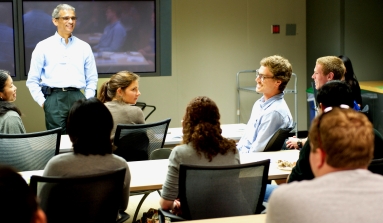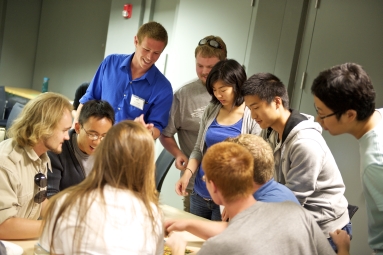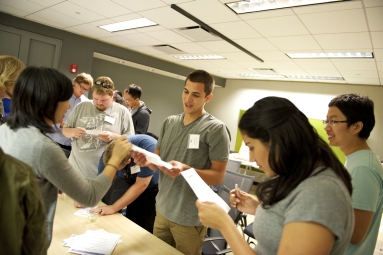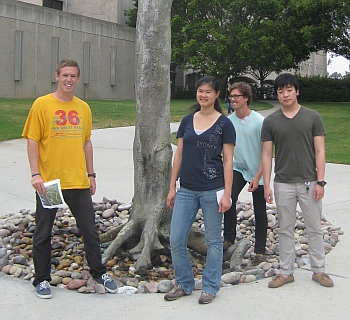Undergrads Spending the Summer as Full-time Researchers
|
San Diego, CA, July 6, 2011 -- Two dozen undergraduates at the University of California, San Diego have begun their summer of being full-time researchers with faculty advisors across campus. The Calit2 Summer Scholars are majoring in more than a dozen different fields from four academic divisions and are working on a wide range of projects.
Their projects also reflect the diversity of their faculty advisors' fields (16 different departments, including four in the School of Medicine) and range from natural communication signals of the European Starling to nanoscale rheological properties of biological fluids; and from body image, health, and nutrition of children: countering popular culture to spontaneous human mimicry playing against Android. A complete list of the students and their projects is below. The scholars are making preliminary presentations of their projects to their fellow scholars this week, which are open to the campus (Thursday July 7, 11:00 a.m. to noon, in room 4004, Atkinson Hall). The students are excited about their projects.
"The mere idea of being consumed by a single, direct impact topic for 10 weeks is exciting, because it's going to be thorough," says Sinduja Marx, "and most importantly it will help detect and perhaps prevent diseases at a very low cost." Marx, a sophomore majoring in bioengineering: biotechnology, with a minor in physics, will work on an Ultrasensitive DNA biosensor.
|
Mallory Pickett, a junior and chemistry major, agrees: "The best thing about being a Calit2 scholar will be the opportunity to focus on research full-time, without classes or needing to work and support myself for the summer." Pickett's project is Chemical Aging of Limonene Secondary Organic Aerosols in the Presence of Substituted Amines. She continues: "I'm really looking forward to the seminars, I think they will be a good chance to develop important skills for grad school."
In addition to providing undergraduates with a unique full-time hands-on research opportunity (the kind usually reserved for graduate students and senior researchers), Calit2's Summer Undergraduate Research Scholarship program enhances the research experience for the scholars with weekly activities (seminars and presentations, as well as social activities). The seminars are designed to help them plan for their future, whether it will be in graduate school or industry. Learning to present their work and practicing giving presentations is also important. The scholars will be presenting their research twice more after this week: several weeks into the 10-week program and at the final poster session scheduled for Welcome Week in late September.
|
The scholars appreciate the multiple aspects of the program. "The best thing about being a Calit2 Summer is the experience. Putting in 40 hours a week for 10 weeks gives a peek into the lives of what a researcher feels like working on their projects on a day-to-day basis," says Marvin Lav, a junior. "Then, there is also the experience gained from giving presentations on their projects, an area I wish to improve in."
Lav, a chemical engineering major, discusses his project: "I'm looking forward to optimizing my experiments and tweaking several aspects of them. My research topic, silver nanocubes, is still novel. It is like a new frontier for things to be discovered. It carries a sense of wonder and excitement to trend this path."
The scholars have had a busy first two weeks; they began with an orientation and get together on June 21 and have also had their first seminar, a tour of Calit2, and a social activity (scavenger hunt). While the social activities are optional, they are required to attend all presentations and seminars, giving them the chance to learn from each other. "I am very excited about my work," says Jonathan Trisnadi, a freshman, "Being able to apply skills on real projects is a very valuable experience. I also look forward to meeting the other scholars and learning from them." Trisnadi, a physics major, will work on AFM tip modification of microrings and photonic circuits.
|
This is the 11th year of the Calit2 Summer Scholars program. The 24 scholars were selected by a committee from a very competitive pool of 101 applicants (the highest number of applicants ever, a 30% increase over last year). The acceptance rate was just under 24%, which meant that many quality students and projects were not able to be funded. In keeping with its multidisciplinary nature, Calit2 encourages students from all academic majors to apply.
The 2011 Summer Scholars are from 16 different majors. For the first time in the history of the program, the overall number of scholars in engineering majors is less than 40% (nine students; 37.5%). Six of these are bioengineering majors, the other three are electrical and computer engineering, engineering physics, and chemical engineering. The rest of the scholarship awardees are about evenly spread out across three other academic divisions: five students from the biological sciences (general biology, biochemistry and cell biology, and physiology and neuroscience); five from the physical sciences (chemistry, biochemistry and chemistry, environmental systems, and physics); and five from the social sciences (cognitive neuropsychology, cognitive science, communication, and international studies). Two additional fields, biological anthropology and history, are represented by two students who are double majors. The majority of the students are juniors, six students are sophomores, and there are three first year students.
Following is a list of the scholars and their projects. More information can be found from the link below to the program website.
| Divya Bhat | STD Transmission Within Latino Communities |
| Angela Chan | Impact of the Uncanny Valley on the Comm. Interaction |
| Bin Du | Assessing the Efficacy of Pax3/Pax7 |
| Josue Gutierrez | How embryonic & adult stem cells regulate growth |
| Cory Jameson | Natural communication signals of the European Starling |
| Selena Kuo | Cigarette smoke induces resistance to doxorubicin |
| Tsz Fung (Garfield) Kwan | The production of lipid for purposes of biofuel |
| Marvin Lav | Silver Nanocubes in an Anisotropic Medium |
| Sinduja Marx | Ultrasensitive DNA biosensor |
| Dina Kats | X-ray crystallography for YscQ in the T3SS |
| Kristine Tan | Cardiac differentiation through non-coding RNAs |
| Nirav Patel | Nanoscale rheological properties of biological fluids |
| Mallory Pickett | Chemical Aging of Limonene Secondary Organic Aerosols in the Presence of Substituted Amines |
| Elham Rahimy | Expression of PTHrP in vestibular schwannoma cell lines |
| Andrew Raub | Investigation of a novel mode of enedyine cycloaromatization |
| Christopher Reinert | Spontaneous Human Mimicry Playing against Android |
| Milena Savovic | Body image health and nutrition of children: Countering popular culture |
| Glenn Schuster | Computational micromagnetics in magnetic nanostructures |
| Damini Tandon | Human mesenchymal stem cells in regen. medicine |
| David Tingley | Basal forebrain neurons relationship with attention |
| Jason Trees | EEG of spatial learning in large-scale virtual environments |
| Jonathan Trisnadi | AFM tip modification of microrings and photonic circuits |
| Liangliang Xiao | Two-photon calcium imaging on motor cortex neurons |
| Peida Zhao | Thermoelectic properties of silicon nanomaterials |
Related Links




